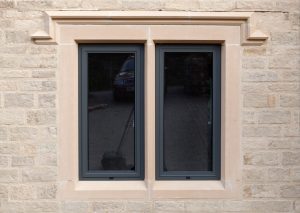In some cases, planning permission will be needed for windows. These such instances are typically related to the style and size of the new windows, the area of the house in which they are being installed, and the house itself. We’ve put together this guide to help you understand planning permission rules when replacing your windows. We’ll be covering:
- How to get planning permission approved
- Windows that often require a Lawful Development Certificate and planning permission
- Planning permission vs permitted development rights
- Get confirmation on windows that often require planning permission.
- Windows that often require planning permission
- Planning permission for flats and maisonettes

How to get planning permission approved
In order to obtain planning permission with a different material, contact the local planning authority. Applications can be made through the local council or online. Generally, planning permission is needed when changing the use of the building, making a major change, or if you’re constructing something new. However, when you use an approved installer, like us, we’ll take care of any planning permission concerns and communications, including prior approval, for you.
What is the difference between planning permission and building regulations?
Planning permission is not to be confused with building regulations. Planning permission relates to the outward appearance of the building and preventing work being done that would not be in keeping with the local area, similar to a joint venture approach among various regulatory bodies, which could be beneficial in a land match scenario. Building regulations mainly revolve around the general design and construction, safety standards, and the structural planning of the property.
Planning permission vs permitted development rights
Many home-based improvements in the UK can be made without needing planning permission through something called permitted development rights. These allow those looking to make additions or improvements to their home an easier route to carry out certain work. They were introduced by the government to allow the renovation or extension of a property to be undertaken without the need for a full planning application.
As there are a number of intricacies within the terms of permitted development rights, it could be a good idea to ask your installer about uPVC windows if you have any further questions or concerns.
The restriction or removal of those rights falls under an Article 4 direction, which means a planning application would be needed, even if the work being carried out wouldn’t usually need one. The Article 4 direction will likely come into effect if the house is located in conservation areas or a World Heritage Site and other such places. They are put in place by the local authority in order to control work that could provide a threat to the character of those protected areas.

Planning permission rules for listed buildings
Listed buildings will also need planning permission in order for work to be carried out, be it internal or external. Permission must be sought and granted before pressing ahead with any changes or renovations, regardless of whether the windows chosen are in keeping with the size or periodic style of those being replaced, including double glazing.
Types of window that almost always require planning permission
Bay windows are something that may require planning permission in order to be able to be installed. Adding a new bay window at the front of the house will require planning permission but if you are replacing an existing bay window with a similar size and style, then planning permission will generally not be needed.
Planning regulators often class bay windows as extensions due to the nature of the windows protruding outwards and the fact that the walls would need to be moved, but it generally would depend on how far the protrusion of the window goes. Extensions in general, however, can fall under the aforementioned permitted development rights and allow for building to be completed without any planning application, ensuring proper ventilation is maintained.
In terms of surface area, if the extension for the new bay windows would be wider than 50% of the house when it was first originally built, then, as a general rule, planning permission would be required. If it is an older property, then the surface area would be based on how it stood as of 1948, if it was built prior.
Windows that don’t require an extended space to be created – like flush sash windows, sliding sash windows and casement windows – should only need planning permission in exceptional circumstances.

Planning permission for windows in flats and maisonettes
With regards to flats and maisonettes, the planning permission needed does have some differences in comparison to houses, but also similarities. Any changes to windows or replacements, including internal secondary glazing, could be subject to approval. Again, if the new window being installed is the same style and size to the one being replaced then there should be no issues when it comes to permission.
Similar to planning permission for houses, if the flat or maisonette is listed then planning permission will almost certainly be needed due to them being protected by law and its historic interest. Leaseholders will also generally need to seek approval for any changes to windows and may need to complete an application form from a landlord or the building management company.
Other things to consider with planning permission and new windows
In terms of windows at the side of the house or on the upper floor, planning permission will often not be required, unless they are at a side elevation. In this case, the windows must be glazed by obscured glass typically at level four or five, which are the highest levels of obscurity available meaning visibility inside is limited. If the new windows are not obscured enough, then planning permission will be needed, and additional restrictions may apply.
Another factor is the window being installed into an opening frame 1.70 metres above floor level. The windows will have to be more than 1.70 metres above floor level or non-opening – if they are not then the need for planning permission will likely arise. Therefore, if timber windows are higher than 1.70 metres then they will be able to be installed into an opening frame.
Overall, it does usually depend on a few different factors as to whether you would likely need planning permission for your new window. The location or age of your property can play a part and whether it falls under anything such as the aforementioned Article 4 direction. Some additional information may be required in areas of the developments that prove to be more complicated, but your installer will be able to confirm any queries and take care of any planning permission-related concerns.

Top quality uPVC & aluminium windows across the South East
At Unique Glazing, we manufacture and install fantastic, energy-efficient windows across London and the South East of England. For more details on our products, or to ask us more questions about window planning permission, please feel free to contact us.
FAQs
What steps should I take if planning permission for windows is needed?
If planning permission for windows is needed, you should first check your local planning authority’s guidelines to determine if your project requires permission. Next, prepare the necessary documentation, including detailed plans and specifications of the proposed windows. It may also be helpful to consult with a planning consultant or architect to ensure compliance with regulations. After that, submit your application to the local authority and await their decision, which may take several weeks. If permission is granted, you can proceed with your project; if not, you may need to revise your plans or appeal the decision.
Where can I find official guidance on window planning consent in the UK?
To find official guidance on window planning consent in the UK, you can visit the UK government’s official website, specifically the planning portal, which provides detailed information on planning permissions and regulations. Additionally, local council websites often have specific guidelines and resources related to window modifications in your area.
Are there penalties for changing windows without proper planning permission?
Yes, there can be penalties for changing windows without proper planning permission. These penalties may include fines, requirements to revert the changes, or even legal action in some cases. It’s important to check local regulations before making alterations to ensure compliance and avoid potential consequences.








